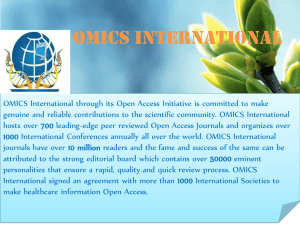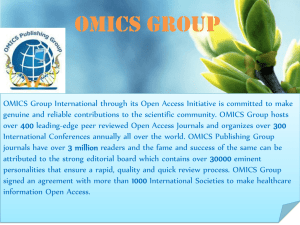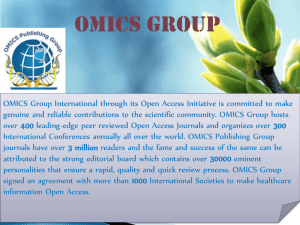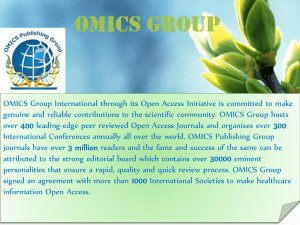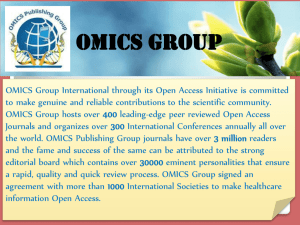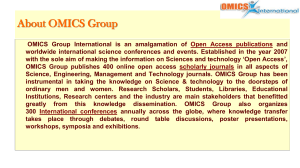PPT Version - OMICS International
advertisement
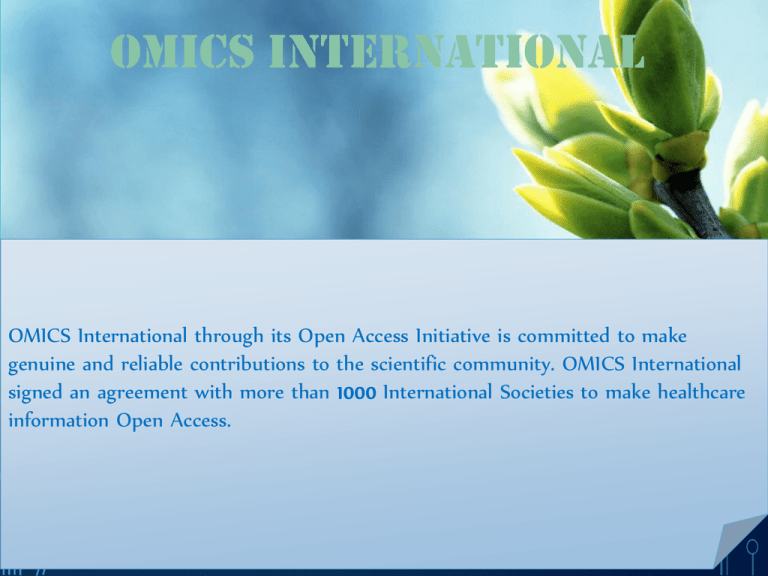
OMICS International OMICS International through its Open Access Initiative is committed to make genuine and reliable contributions to the scientific community. OMICS International signed an agreement with more than 1000 International Societies to make healthcare information Open Access. Contact us at: contact.omics@omicsonline.org OMICS Journals are welcoming Submissions OMICS International welcomes submissions that are original and technically so as to serve both the developing world and developed countries in the best possible way. OMICS Journals are poised in excellence by publishing high quality research. OMICS International follows an Editorial Manager® System peer review process and boasts of a strong and active editorial board. Editors and reviewers are experts in their field and provide anonymous, unbiased and detailed reviews of all submissions. The journal gives the options of multiple language translations for all the articles and all archived articles are available in HTML, XML, PDF and audio formats. Also, all the published articles are archived in repositories and indexing services like DOAJ, CAS, Google Scholar, Scientific Commons, Index Copernicus, EBSCO, HINARI and GALE. For more details please visit our website: http://omicsonline.org/Submitmanuscript.php EB PPT Xincun Dou, male, born in May, 1981, PhD, professor of the Xinjiang Technical Institute of Physics & Chemistry, Chinese Academy of Sciences (CAS). He got his bachelor’s degree from East China Normal University in 2004. Since obtained his doctor’s degree in materials physics and chemistry at Institute of Solid State Physics, CAS in 2009, he has been working in the same institute as an assistant professor till Jul, 2011. During the period of Nov 2009 to Nov 2011, he worked as a research fellow at Energy Research Institute @ NTU, Nanyang Technological University. In Jul 2011, he got his current position. He was engaged in high performance new materials related to energy harvesting and environment protection, such as thermoelectric materials, solar energy harvesting materials, photocatalyst etc. And at the same time to understand the underlying mechanisms. The device performance is of particular interest. He has authored more than 30 research articles and one book chapter. He has been honored as “Excellent president award of CAS” and “Excellent young scholar award” in C-MRS previously. Thermoelectric materials, solar energy harvesting materials, photo catalyst etc. •It is a process by which a photochemical alteration occurs in one molecular entity as a result of initial absorption of radiation by another molecular entity called the photosensitized. •Chlorophyll of plants is a type of photocatalyst •The difference between chlorophyll photocatalyst to man-made nano TiO2 photocatalyst (here below mentioned as photocatalyst) is, usually chlorophyll captures sunlight to turn water and carbon dioxide into oxygen and glucose, but on the contrary photocatalyst creates strong oxidation agent and electronic holes to breakdown the organic matter to carbon dioxide and water in the presence of photocatalyst, light and water. Photocatalyst material requirements Band gap: Band gap>1.23eV and sufficiently small to make efficient use of solar spectrum (~<3eV). Band levels suitable for water splitting. High Crystallinity: Defects can act as recombination sites. Long term stability: Charge transfer used for water splitting and not corrosion. Process H2O→2H2+O2 ∆V=1.23V, ∆ G=238kJ/mol Step 1: Photon with energy above 1.23eV (λ<~1000 nm) is absorbed. Step 2: Photoexcited electrons and holes separate and migrate to surface. Step 3: Adsorbed species (water) is reduced and oxidized by the electrons and holes. Self Cleaning: Windows, mirrors, tiles and other surfaces. 1.Analytical & Bioanalytical Techniques http://omicsonline.org/analytical-bioanalyticaltechniques.php 2.Chromatography & Separation Techniques http://omicsonline.org/chromatography-separationtechniques.php Xincun Dou OMICS International Open Access Membership OMICS International Open Access Membership enables academic and research institutions, funders and corporations to actively encourage open access in scholarly communication and the dissemination of research published by their authors. For more details and benefits, click on the link below: http://omicsonline.org/membership.php

